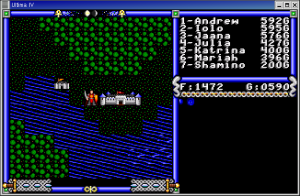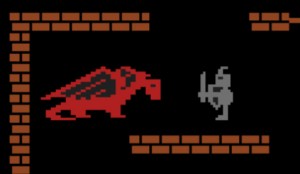RPG Design: Getting In Over Your Head
Posted by Rampant Coyote on June 24, 2014
 When I was a kid, I dreamed about a computer RPG that (in my dream) was completely awesome. Amusingly, although the end of the dream was more like a live-action adventure, the first half of the game in my dream was probably closer to something like the early Ultima games. Setting forth from the first castle, I bravely set forth into the tile-graphics world … in the wrong direction.
When I was a kid, I dreamed about a computer RPG that (in my dream) was completely awesome. Amusingly, although the end of the dream was more like a live-action adventure, the first half of the game in my dream was probably closer to something like the early Ultima games. Setting forth from the first castle, I bravely set forth into the tile-graphics world … in the wrong direction.
I found myself in the “high-level” area of the game very early, lost, and desperately trying to find my way back to where I was supposed to be.
It culminated with what felt more like a live-action adventure, with me in a vampire’s castle at the still-lowly level of 1, realizing I was still not back to where I wanted to be, but still able to make some progress so long as I avoided any combat. The encounter with the vampire resulted in yet another panicked flight, facilitated by his great weakness: predating the Doctor Who episode “Blink” by more than two decades, he would only be able to approach if I looked away.
While it was a very cool dream that I still remember parts of to this day, I think your average player would grow super-frustrated and quit (or at least restart) early on.
Maybe one source of inspiration for this little dream of mine back in the day was my misadventures in the game Telengard, a game which frequently dropped you down pits or teleported you to random locations in the dungeon – and, often, to areas where you had no business being. If you didn’t have a scroll of rescue, you’d be in for a really tough adventure (especially since, IIRC, you could only save the game up at the top of the dungeon, in one of the taverns).
 However, one of the fun things to do in Telengard was to actually memorize a path down to a level well beyond your ability, “snarf up” some unprotected treasure, and then get back to safety and save the game (where the treasure was converted to experience points). Sometimes monsters would even be friendly and give you a powerful magic item. Other times, you had to be able to survive long enough to flee. Fleeing in Telengard basically meant getting a certain number of “moves” ahead of your pursuers. There was a little graphical character that marked how far behind you they were.
However, one of the fun things to do in Telengard was to actually memorize a path down to a level well beyond your ability, “snarf up” some unprotected treasure, and then get back to safety and save the game (where the treasure was converted to experience points). Sometimes monsters would even be friendly and give you a powerful magic item. Other times, you had to be able to survive long enough to flee. Fleeing in Telengard basically meant getting a certain number of “moves” ahead of your pursuers. There was a little graphical character that marked how far behind you they were.
Lars Doucet posted some time ago about fleeing mechanics and design – adding the ability to “run away” from a bad encounter. You can click here and check out his excellent article, “Run Away!”
Back in 1999 or so, Gary Gygax wrote about how games like D&D had changed to be more like video games (and video games had themselves moved in that direction) so that a player was expected to “clear out” a level before proceeding further into an area. This wasn’t really how the old games worked. Back in the day, while easier monsters did tend to congregate in the nearer areas, there was no guarantee that everything in the first level of the dungeon was conveniently of level 1 difficulty. If you tried to go in with guns blazing (well, swords slicing) into every encounter, your party would wipe out early and often.
Things change, I suppose.
Now games tend to gate off the harder content. Or, in more open-world games, there’s some “auto-scaling” that takes place to make sure the content matches the character level. The latter may be somewhat analogous to a game master who makes sure the adventure is always tailored to the party level in a dice-and-paper game. But both approaches rob the game of a good chunk of the fun… the feeling that the world is big and scary and not revolving around the player(s). In either case, you rarely feel like you’ve truly gotten in “over your head.”
 I was playing Might & Magic X: Legacy recently, and found that I’d managed to get myself turned around and going deeper and deeper into very difficult content. While that was kinda cool, you really cannot escape encounters, and if you stick to backtracking paths you’ve already taken, unless you’ve triggered some kind of event that has spawned new enemies, you don’t have to worry about unplanned encounters.
I was playing Might & Magic X: Legacy recently, and found that I’d managed to get myself turned around and going deeper and deeper into very difficult content. While that was kinda cool, you really cannot escape encounters, and if you stick to backtracking paths you’ve already taken, unless you’ve triggered some kind of event that has spawned new enemies, you don’t have to worry about unplanned encounters.
There’s even a warning sign in an early area about the ability for players to wander off into areas well beyond what the party is ready for. I like that, but it only takes me part-way there. For me, the real fun of of being able to wander off into far-too-difficult situations comes from:
#1 – Having a reasonable chance to recognize, avoid, and escape a combat that’s clearly out of your league.
#2 – A constant threat looming so long as you are in a dangerous area.
#3 – Not taking too much frustrating effort to make it to safety.
#4 – A chance of “getting lucky” and deriving a valuable benefit from your excursion.
This was something I always enjoyed about the Thief games. You were always in over your head, and you knew it. Too much of that, though, and the pressure lost its charm. But taken a mission at a time, it was awesome fun.
 This is also a point where player skill really comes into play. When everything is tailored to your character level, the gameplay ends up being little more than repeating a regular set of straightforward tactics to get an “edge” over what is otherwise a pretty brute-force slugfest. But when faces with superior foes, where a brute-force battle would be completely overwhelming, that’s when the player really has to be resourceful. Maybe the correct application of some rarely used items and some really clever tactics might allow the to prevail in a fight, particularly if its not too overwhelming. Maybe diplomacy or stealth or out-and-out flight are better approaches. And maybe, just maybe, I might be able to snatch a victory or two – if only in the form of loot or a higher-level quest – out of the experience.
This is also a point where player skill really comes into play. When everything is tailored to your character level, the gameplay ends up being little more than repeating a regular set of straightforward tactics to get an “edge” over what is otherwise a pretty brute-force slugfest. But when faces with superior foes, where a brute-force battle would be completely overwhelming, that’s when the player really has to be resourceful. Maybe the correct application of some rarely used items and some really clever tactics might allow the to prevail in a fight, particularly if its not too overwhelming. Maybe diplomacy or stealth or out-and-out flight are better approaches. And maybe, just maybe, I might be able to snatch a victory or two – if only in the form of loot or a higher-level quest – out of the experience.
The worlds of CRPGs these days really are too “safe” and too well-structured. They can often feel more like amusement park rides than an adventure. I want to get into trouble.
Filed Under: Design - Comments: 6 Comments to Read
McTeddy said,
Yep, I agree completely. Leave the guards in the door telling me “Only an idiot would go this way…” but LET ME BE AN IDIOT!
I prefer a higher level of challenge than the average player. Autoscaling or level gates that force me to be an average player are a sure-fire way to make me hate your game.
I miss the days where I could go on MY adventure, even if it was stupid and suicidal.
Andy_Panthro said,
I’m reminded of the brilliant example (in so many ways) of Quest for Glory.
In the first game, if you’re good enough, it’s perfectly possible to assault the bandit lair from the front entrance.
You’re supposed to sneak in the back way, but I always liked that the option was there.
There’s also a few other tough fights that are completely optional.
Surloc said,
I remember QoG bandit lair. I decided wanted to try the front door with my thief. I had to spend a couple days doing a workout plan spar, clean the stables, fight the goblins, flame dart all my mana, run around half the night killing things…
Anon said,
The games I fell most comfy with are the ones that let me choose the approach – like Deus Ex, the Thief games (even though a brutal assault was usually out of the question) or the newer Dishonor.
This massively increases immersion as I have more options what to do and don’t feel too restricted compared to other games that force me into a specific direction.
However, this is sometimes not without problems!
The first Deus Ex was funny in this regard, for example: While you could choose different methods to get to your target the game works by checking where the player enters – and you can even add XP points by doing different approaches one after the other. Technically, there seem to be “zones” or “borders” the player can cross and the game then gives you a set amount of points for it – regardless if he had already entered the target area earlier via another route.
Needless to say that you can get many enhancements early on in the game if you take advantage of this “oversight” as you maximize the amount of points.
The game also doesn’t break but your immersion perhaps does, at least to some small degree…
Picador said,
The feeling you’re describing is EXACTLY why everyone was so excited about Demon’s Souls when it came out. It’s a game where you routinely run into enemies you’re not tough enough to fight. You spend a lot of time sneaking past and running away from your enemies, and even the most basic fight can be nerve-wracking. You also spend a lot of time trying to run or sneak past enemies so you can grab a piece of loot or open up a new secret passageway. Like early D&D, it’s about risk/reward calculation, exploration, and trying to snag loot by hook or by crook as opposed to just fighting everything in your path.
Now that Dark Souls and Dark Souls 2 are on PC, have you had a chance to play them?
Rampant Coyote said,
I have Dark Souls (from a Steam sale), but haven’t played it yet. But everyone’s been telling me how awesome it is.